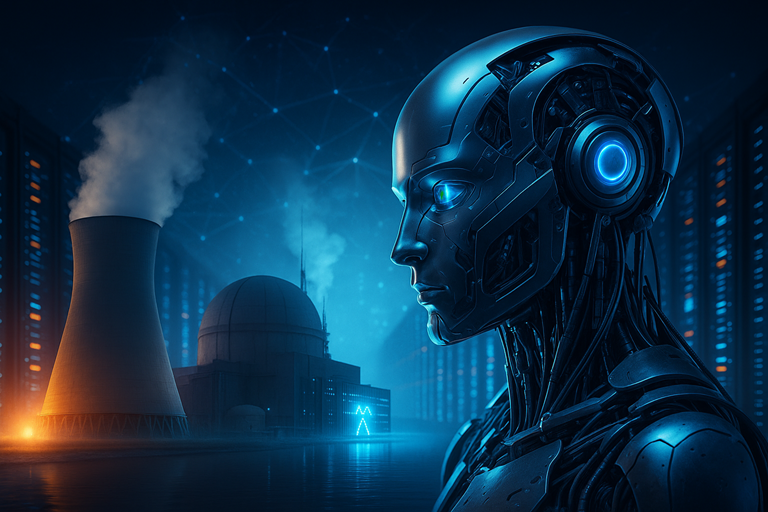💻⚡ From Silicon to Atom: Small Modular Reactors, the Beating Heart of AI Data Centers 🤖☢️
🤖⚡ Powering AI: Why Data Centers Need SMRs ☢️
In an era where artificial intelligence is growing at a staggering speed, the main question is no longer "What does it learn?" but "What feeds it?" 💡
Data centers that once ran on a few megawatts now require hundreds of megawatts — equivalent to the electricity of a medium-sized city 🏙️. Traditional grids can’t keep up, and this is where Small Modular Reactors (SMRs) step in ☢️⚡
"Imagine a massive data center with thousands of servers processing data nonstop, and suddenly the power goes out. Every second of downtime costs thousands of dollars ⚡. Now imagine a stable and predictable energy source, like an SMR, ensuring that power flow — the future of AI is in your hands"
SMRs promise sustainable, clean, and predictable energy 🌱 For data centers, this means freedom from costly and unpredictable outages 💻⚡
⚡ Data Center Energy Challenges and Future Options 🌍
Massive deep learning models, such as GPT and other large AI models, require staggering amounts of electricity 💡. Forecasts suggest that by 2030, data center power consumption will exceed 900 terawatt-hours — equivalent to the electricity usage of a mid-sized industrial country 🏭. Current power grids cannot handle such a heavy load
Renewable energy sources like solar and wind are also dependent on weather conditions ☀️🌬️. AI cannot stop. Every moment of downtime results in thousands of dollars in losses 💸
🔹 Future Options
| Energy Source | 24/7 Reliability | Initial Installation Cost | Carbon Pollution | Suitability for Data Centers |
|---|---|---|---|---|
| Fossil Fuel ⛽ | ✅ Yes | 💰 Medium | ⚠️ High | ❌ Temporary and not aligned with environmental goals |
| Wind & Solar Energy ☀️🌬️ | ❌ Weather-dependent | 💰 Variable | ✅ Low | ⚡ Good as a supplement, not as a primary source |
| Small Modular Reactor (SMR) ☢️ | ✅ Yes | 💰 High but predictable | ✅ Zero during operation | 🌟 Highly suitable for large data centers |
💬 "Choosing the right energy source makes the difference between a sustainable data center and a high-risk one." — Dr. Elnaz Mousavi, Sustainable Energy Consultant
☢️ What Are Small Modular Reactors (SMRs) ? ⚡
SMRs are a new generation of nuclear energy that are manufactured in factories and then installed modularly 🏭. Each reactor typically has a capacity between 5 to 300 megawatts, enough for medium to large data centers 💻
- 🛡️ High safety with passive and natural cooling systems
- ⚡ Faster installation: 2–4 years compared to 10 years for large power plants
- ➕ Expandable capacity by adding modules
- 💰 Low long-term maintenance costs
- 🌱 Zero carbon emissions during operation
💬 "SMRs can become the backbone of sustainable energy for next-generation data centers." — Engineer Elnaz Mousavi, Nuclear Energy Consultant
🔗 Real-World Examples and Trusted Sources ⚡
Microsoft has started SMR testing at Three Mile Island 🏭. Google collaborates with Kairos Power, and Amazon invests in SMR projects through AWS 💻⚡
Startups like Oklo and Vertiv are designing systems to recycle waste heat for data center cooling 🌱❄️. These innovations demonstrate that combining AI and nuclear energy is practical and effective 🔬🤖
- ✅ Microsoft: SMR testing at Three Mile Island
- ✅ Google: Collaboration with Kairos Power to optimize AI energy
- ✅ Amazon (AWS): Investment in SMR projects
- ✅ Oklo & Vertiv: Waste heat recycling and data center cooling
🌟 Strategic Advantages of SMRs for Data Centers ⚡
Small Modular Reactors are not only a reliable energy source but also provide unique strategic opportunities for data centers 💻🤖
- 🔌 Independence from the Grid: Data centers are no longer reliant on the public electricity network
- ⚡ Guaranteed Operational Stability: No unexpected outages or downtime
- 🌱 Alignment with Net-Zero Goals: Significant reduction of environmental impact
- 💰 Predictable Costs: Accurate budgeting and reduced financial risks
- ❄️🔥 Use of Waste Heat: For data center cooling or district heating
💬 "SMRs go beyond electricity generation; they strengthen the entire operational ecosystem of data centers." — Dr. Sara Rahimi, Energy and Sustainable Technology Consultant
⚠️ Challenges and Realities in Using SMRs and Other Energy Sources ⚡
Licensing, initial investment, and public perception are among the main challenges 🏛️💰. HALEU fuel is limited and expensive, but with improved designs and mass production, costs decrease and operational regulations become easier 🔧📈
| Option | Advantages ✅ | Challenges ⚠️ | Best Use 🌟 |
|---|---|---|---|
| SMR ☢️ | 24/7 reliability, clean energy 🌱 | 💰 Initial cost, 🏛️ Licensing | Large data centers 💻 |
| Renewables + Battery ☀️🌬️🔋 | Quick installation, eco-friendly 🌍 | ❌ Weather-dependent, storage limitations | Backup or hybrid ⚡ |
| Traditional Grid ⚡ | Immediate access ⏱️ | Pollution 🌫️, instability ⚠️ | Temporary ⏳ |
💬 "Every technology has its advantages and challenges, but SMRs best align with the needs of AI data centers." — Dr. Arash Karimi, Nuclear Energy Consultant
📊 Data Center Energy Consumption Growth vs. SMR Capacity ⚡
This chart compares the growth of data center energy consumption with increasing SMR capacity. As you can see, SMRs can cover a large portion of data center needs by 2040 🌱☢️
💬 The chart shows that with SMR development, data centers can align their growing energy consumption with sustainable sources
🌌 Future: From Cloud to Atom ⚡
SMRs and massive data centers provide sustainable energy 🔋💻This combination creates a continuous cycle of energy and data that will become the backbone of 21st-century digital civilization 🌐✨
💬 "Nuclear reactors will not be a threat, but guardians of the energy for humanity's artificial mind." — Professor Linda Johnson, MIT
⚡ The future of AI and nuclear energy are intertwined, promising a sustainable and intelligent world
📝 Summary 🌟
🌌 From silicon to atom, from light to data, this is the future of our digital civilization
Frequently Asked Questions (FAQ) 💡 ❓
SMRs operate modularly with natural cooling systems and can continuously generate electricity ⚡💻
With passive design and multiple safety systems, SMRs are much safer than traditional power plants 🛡️☢️
The initial cost is high, but over its lifetime, with energy savings and reduced downtime, it is economical 💰📈.

